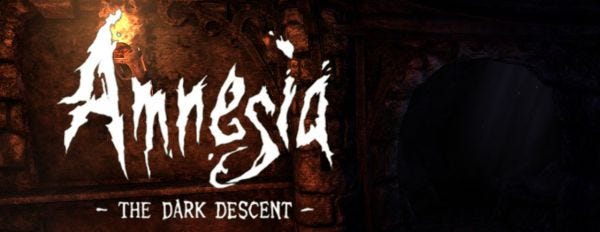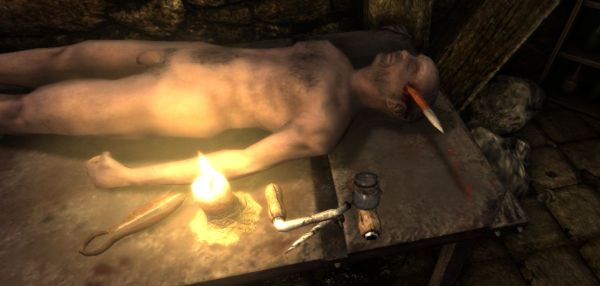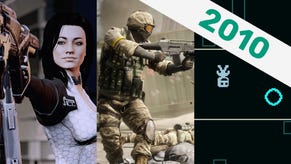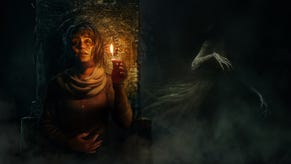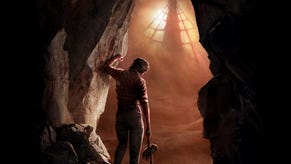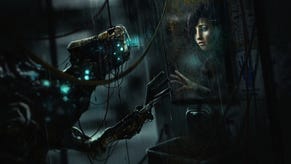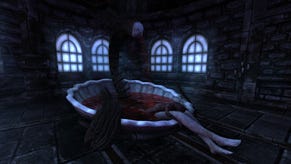Wot I Think: Amnesia - The Dark Descent
Frictional's first full-length game, and a successor to their Penumbra series, comes out tomorrow. Amnesia is a combination of classic haunted castle horror with their unique first-person adventuring. Is it good? Is it scary? (Let me give you a clue: flipping yes, and oh good grief yes.) Read on to find out just exactly Wot it is that I Think.
Paint the man, cut the lines. Paint the man, cut the lines. Paint the man, cut the lines. Paint the man, cut the lines. Paint the man, cut the lines. Paint the man, cut the lines. Paint the man, cut the lines. Paint the man, cut the lines.
Help me.
Good flipping grief on a barge, Amnesia is a scary game. There is no question, not one, that it has instantly equalled with the original Thief in terms of making me feel like I’m constantly on the verge of a hideous heart attack. If it failed at everything else – and it absolutely does not – then it would still be an extraordinary achievement simply for so ceaselessly inducing ghastly fear.
However, Amnesia achieves on so many levels, from phenomenal architecture to astonishing visual design, from exquisite use of darkness to a game-changing use of physics. It has shortcomings too, and I’ll get to them, but this is an overall tale of impressive success.
But most of all, it’s the fear.
You’re walking down a barely lit corridor, bleak with shadows. You light a single candle on the wall, more to mark that you’ve been this way than to provide any respite. But suddenly everything starts shaking, a roaring crash deafens you, and in front of your is a rockfall blocking your path. So you turn around to make your- WHAT THE HELL IS THAT?
Stood in front of your is the horror of a mutant, its face in a ghastly, deadly yawn, arms twitching, staggering toward you. It hasn’t seen you yet, but the music has, and it’s become discordant, threatening. Daniel’s breathing picks up, his vision stretches out thin, before swimming slowly back to normal. But you’re lit by that candle, and it’s going to-
It’s seen you, and the screech begins. It’s not a scream, not a roar, something between, one tone, horrendous. It speeds up, charges, and you can only run. Darting past, it clips you with a talon-finger, a slice of blood ripping across the screen. Daniel staggers, his sight goes red, but you keep your finger on sprint and you just run, in darkness, no idea where you’re going. Finally there’s a door. You race in, and slam it shut behind you, and run into the darkest corner, crouch, and face the wall.
It’s growling moan still grows louder, and then you hear it slam against the door. Its fists batter at the wood, and you turn around to see splinters flying off, then a hole punched through. Face the wall. Just face the wall.
Whether it comes in to find you, or loses you in the darkness, is up to the moment. But you can’t turn around to find out what it’s doing – see it, and Daniel will react, perhaps make a noise. That’s death. So you stay there, panicking, panting, staring at stones, unsure if it’s even in the room any more.
While the idea of a player character who’s lost their memory may induce a groan, here’s the game that’s allowed to do it. This allows a narrative of gradually revealed horrors to seep back in as you progress through the first-person adventuring.
And it really is adventuring, but in a way that - if only any other developer in the world had had the sense to copy from Frictional’s previous Penumbra series – should be the genre’s new direction. Taking Penumbra’s technological reigns, once again this is a collection of large, complex physics puzzles, combined with exploration and inventory application. However, unlike Penumbra, there’s no combat whatsoever. That there’s still deadly enemies is in a large part why this is so damned scary.
You play Daniel, an explorer who apparently discovered some sort of magical orb. The only knowledge you have of yourself are the notes you left behind, and the memories that assault you as you enter certain locations. Why you’re stuck in a giant castle, and where you’re going, are unknowns. And because the narrative cleverly doesn’t come together in a meaningful way until the final acts, I’ll not say a word more.
So your objective is progression. Get away from where you are, because it’s bloody terrifying, and try to move on. And you can’t stick around, because the building itself is corrupting around you, the rocks growing horrendous pulsating flesh and exploding pustules.
Or more often it’s because you’re running for you life, too scared to turn around, racing until you can find a door to slam shut behind you. Really, having the character make yelps and frightened breathing sounds is completely unnecessary – I was making plenty of my own.
Running is the last resort. Ideally, should you hear the guttural groans of the grotesque mutant creatures that stalk the castle’s halls, you hide. Anywhere. Turn off your lantern, run toward darkness, and crouch. If you can find a wardrobe, climb in it and close the doors. Because you cannot fight back, and any attempts would be hopeless.
Running to darkness is quite the opposite of your usual intent. Darkness leads to fear, and fear leads to insanity. To maintain your mental acumen, you need to seek light, and it’s in extremely short supply. The building is inevitably plunged in black, and too long without being able to see properly causes Daniel to begin losing his already fragile mind. You discover a lantern early on, but the game’s rarest commodity is lantern oil, and you’re going to want to ration it for emergencies. The other option is finding tinderboxes to light lamps, torches, candles or fireplaces. These offer a faint glow in the gloom that can allow you to keep a grip on reality. But again, tinderboxes aren’t in wide supply, and you’re going to have to think carefully about where to create light.
The loss of sanity can only be restored by progression. (An absolutely fantastic improvement on the preview version’s Sanity Potions, that really made no sense at all). This is either geographical, or completing puzzles. It makes sense. These moments provide calm, offer satisfaction. It allows you to believe you’re having an impact, making a difference, and not just the victim to this horror show.
But insanity is rife, and you will be subject to it. The portrayal is splendidly evocative. The screen contorts, bellows, and woozily twists. Colours bleed, the world blurs, and you lose full control of your movement. At worst your legs give way from underneath you, and you’re left dragging yourself across the floor by your arms. And the sound. God, the sound. The screeching, screaming, wailing. The tinnitus drone, the whispering voices, the distorted, atonal instruments. Help me.
Every moment of sound is a masterpiece (with the exception of the voice acting, which is mostly decent, but rarely brilliant). The thumping machinery, colossal chains and cogs, dripping viscera, unholy moans, and swelling tunes constantly conspire to terrify you in even the most gentle moments. Add to this Daniel’s frantic breathing whenever he’s scared, and his little yelps of terror when surprised, and you’re left a gibbering wreck.
Those enemies – it’s not just a case of hiding from them. You can’t even look at them. Their sight is too frightening for Daniel, quickly tipping him over the edge.
It’s crazy how affecting it is, every time. I found myself chanting, “Only a game. Only a game.” But it didn’t work. And I think at the point where a horror game has anyone tell themselves, “It’s only a game”, it’s unquestionably a success.
One particularly horrendous (in the good way, you understand) sequence involves negotiating flooded chambers, stalked by an invisible beast. You can see its footsteps splashing in the water, and it can only detect you by yours. I’ll not ruin a moment of that bit, as it’s possibly the game’s greatest scene, but wow it inflicts terror.
The sense of urgency to get back onto a box, out of the water and onto the safety of a crate, is insane. The whole of my body tensing as the click of my mouse becomes more intense, more frantic, leaning forward in my chair as if that will help me climb to safety more quickly, my spine and chest tingling with urgent fear.
Things are so much more effective for the remarkable way you interact. It’s similar to Penumbra, except without the key to have the mouse become a cursor. Instead you use the central reticule to interact, pointing it at objects. When you can interact a hand icon appears, which lets you click on something to manipulate it. And you manipulate it in a tangible, real way. Opening a drawer isn’t clicking the button to initiate the drawer opening. It’s gripping the handle of the drawer, and then pulling it toward you. It moves as a drawer moves, as quickly as you pull it. Should there be an object inside, it will slide forward if you give the drawer a sharp tug. It’s so simple, but crikey, it makes such a difference.
The same goes for opening and closing doors, which makes that earlier description of slamming doors behind enemies literal. You can gently creak them open, just a crack, to peer through. Or slam them against the wall behind in a mad rush. Objects can be picked up, and sort of magically float in front of you – you have to imagine your arms for yourself. They can be rotated, and thus stacked into improvised structures. You can build ramps, or impromptu staircases to reach areas, from any local furniture.
It’s utter lunacy that more games haven’t mimicked this, but if Amnesia is the success it deserves to be, perhaps it will finally be noticed. For adventure gaming it’s the ideal solution to 3D, letting you apply inventory objects in the real world.
What I found most remarkable about this was the nonchalance with which I applied it. Stood by a balcony in the gloom, I wanted to know how high up I was. So I picked up a stone from the floor and dropped it over the side, and waited for the clatter. It wasn’t until I’d done it that I realised that no game had ever needed me to do this, let alone made it so instinctively possible.
There’s some silliness in there too. An unfortunate side effect of having puzzles be solved by improvising with the surrounding items is highlighting how daft it is when it requires a specific object in a specific place. One scene needs a rope to lower a container into a hole in the ground. The room is decorated with non-interactive spools of rope, but you have to find the correct bit of string in another location to get anywhere. A normal oddity for gaming, but here it stands out a little bit more. The hammer and chisel in your inventory is used to get past quite a lot of challenges, but there’s many where they’d clearly work but the game just says no.
The script isn’t perfect. There’s some broken English in a couple of places, and a huge number of very long letters you find aren’t voiced. Stopping to read a missive that doesn’t make narrative sense yet doesn’t really fit into the panicked theme of the game, and often things are so obscure that it’s hard to pull it all together in your head. By the end the core plot does come together extremely well, but there’s a lot that’s left confusing because you didn’t do your comprehension homework properly. Daniel’s voice veers between competent and a bit overly pantomimed, often quite mood-breaking. But Alexander’s – and you can learn about him yourself – is great.
But so much more is done so well. There’s an almost Valve-level of smartness with visual cues, and I cannot think of a game that uses audio cues better. Most times I got stuck anywhere were because I was forgetting to listen.
And did I mention it’s scary? I was inventing new swears by the end of it. “Fucking cocksticks, what the shitstack was that?!” And I confess I yelped on more that one occasion. One of them might be considered, by some, to be a squeal. But more often I’d find myself rigid with fear, my stomach pressed against my desk as I leaned into the monitor trying to reach the next illusion of safety more quickly. I think it is safe to say that Amnesia is the most successfully frightening game to have been made. It feels perhaps a slightly over-obvious observation, but the compliment is utterly valid: It’s Thief III’s Cradle as a full game. Unrelenting in its scares and jumps.
That this was made by a five-man team who built their own engine is bewildering. At around ten hours long, that it’s £13 (and discounted currently to pre-order for tomorrow’s release on Steam, GamersGate, and presumably elsewhere) is amazing value. If you pre-ordered it, you can start pre-loading now via Frictional's site. I cannot recommend it enough. So long as you don’t mind being utterly bloody terrified.
